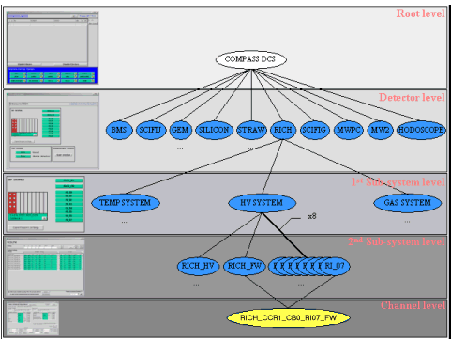Tree hierarchy can be understood as a set of "node" elements and "leaf" elements. All the node elements in this tree are datapoints of JCOP-FW datapointType called _FwNode (ref. JCOP FW document). Leaf element can be understood as a real device, a channel, of experiment holding some value(s) of read hardware. All the leaf elements (like HV channel, PLC channel, etc.) are located somewhere in the tree hierarchy and the quantity of node elements before the leaf is different between detectors and sub-systems.
In Figure 2 is showed part of the tree hierarchy of DCS. Tree can be divided into root level, detector level, one or more sub-system level(s) and channel level. On the left side of each levels is showed the example of panel belonging to the level. All the blue elements in the tree represents a node devices and yellow leaf element can be found at the bottom of the hierarchy. From detector level can be found all the detectors connected to DCS. All the read parameters of detectors can be cathegorized into a different sub-systems by using node elements. This is an example taken from HV system of Rich detector where is two sub-systems between detector layer and leaf element. Anyhow there is no restriction of the depth of the tree i.e. one can have as many nodes before leaf element as one wants.
The one of the advantages of tree hierarchy is that it makes possible the alarm propagation. If the leaf element causes an alarm in the system this alarm is brought up to detector level through all the nodes before leaf element and detector layer. In the example of the picture the alarm could be seen not only in RICH_CCR1_CB0_RI07_FW element but also in following node elements: RICH_FW, RI_07, HV_SYSTEM and RICH.

Figure 2: Tree hierarchy